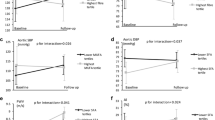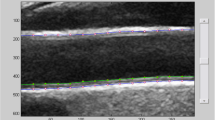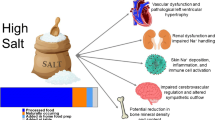Abstract
Purpose
There is global consensus on the benefits of reducing excessive salt intake. Indeed, lower salt intake associates with reduced arterial stiffness, a well-established predictor of cardiovascular risk, in older populations. Whether high habitual salt intake in healthy normotensive youth may already contribute to increased arterial stiffness is unknown. We, therefore, determined whether estimated salt intake is associated with large artery stiffness in young healthy black and white adults.
Methods
We included 693 black and white adults (51% black; 42% men), aged 20–30 years. Participants were normotensive based on clinic blood pressure, and no previous diagnosed chronic illnesses. We measured carotid femoral pulse wave velocity (cfPWV) and determined estimated salt intake based on 24 h urinary sodium excretion.
Results
We found estimated salt consumption of > 5 g/day in 47% of our population, whereas 21% consumed > 10 g/day. In multivariable-adjusted regression analyses a positive association existed between estimated salt intake and cfPWV in the total group (Adj. R2 = 0.32; std. β = 0.10; p = 0.007), and black adults (Adj. R2 = 0.37; std. β = 0.12; p = 0.029). This was independent of age, sex, mean arterial pressure, and other covariates. No association was evident in white individuals (p = 0.19).
Conclusion
Excessive salt intake is positively associated with large artery stiffness—independent of blood pressure—in young adults, especially in black individuals. Our results suggest a potential contributory role of salt consumption towards early vascular aging.

Similar content being viewed by others
Change history
04 August 2018
In the Original publication of the article Fig. 1 was published incorrectly. The correct figure is given below. The original article has been corrected.
References
Stolarz-Skrzypek K, Kuznetsova T, Thijs L et al (2011) Fatal and nonfatal outcomes, incidence of hypertension, and blood pressure changes in relation to urinary sodium excretion. JAMA 305:1777–1785. https://doi.org/10.1001/jama.2011.574
Mozaffarian D, Fahimi S, Singh GM et al (2014) Global sodium consumption and death from cardiovascular causes. NEJM 371:624–634. https://doi.org/10.1056/NEJMoa1304127
O’Donnell M, Schutte AE, Mann JF et al (2016) Dietary sodium and cardiovascular disease risk. NEJM 375:2404–2406. https://doi.org/10.1056/NEJMc1612304
World Health Organization (2012) Guideline: sodium intake for adults and children. World Health Organization, Geneva. http://www.who.int/iris/handle/10665/77985. Accessed 29 March 2017
Powles J, Fahimi S, Micha R et al (2013) Global, regional and national sodium intakes in 1990 and 2010: a systematic analysis of 24 h urinary sodium excretion and dietary surveys worldwide. BMJ Open 3:e003733. https://doi.org/10.1136/bmjopen-2013-003733
Titze J, Luft FC (2017) Speculations on salt and the genesis of arterial hypertension. Kidney Int 91:1324–1335. https://doi.org/10.1016/j.kint.2017.02.034
D’Elia L, Galletti F, La Fata E et al (2018) Effect of dietary sodium restriction on arterial stiffness: systematic review and meta-analysis of the randomized controlled trials. J Hypertens 36:734–743. https://doi.org/10.1097/HJH.0000000000001604
Mitchell GF (2014) Arterial stiffness and hypertension: chicken or egg? Hypertension 64:210–214. https://doi.org/10.1161/HYPERTENSIONAHA.114.03449
Koivistoinen T, Lyytikäinen L-P, Aatola H et al (2018) Pulse wave velocity predicts the progression of blood pressure and development of hypertension in young adults novelty and significance. Hypertension 71:451–456. https://doi.org/10.1161/HYPERTENSIONAHA.117.10368
Vlachopoulos C, Aznaouridis K, Stefanadis C (2010) Prediction of cardiovascular events and all-cause mortality with arterial stiffness: a systematic review and meta-analysis. J Am Coll Cardiol 55:1318–1327. https://doi.org/10.1161/CIRCOUTCOMES.112.966903
Bochud M, Staessen JA, Maillard M et al (2009) Ethnic differences in proximal and distal tubular sodium reabsorption are heritable in black and white populations. J Hypertens. https://doi.org/10.1097/HJH.0b013e32832104b1
Palacios C, Wigertz K, Martin BR et al (2004) Sodium retention in black and white female adolescents in response to salt intake. J Clin Endocrinol Metab 89:1858–1863. https://doi.org/10.1210/jc.2003-031446
Marfell-Jones MJ, Stewart A, de Ridder J (2012) International standards for anthropometric assessment. Potcheftroom, South Africa
Van Bortel LM, Laurent S, Boutouyrie P et al (2012) Expert consensus document on the measurement of aortic stiffness in daily practice using carotid-femoral pulse wave velocity. J Hypertens 30:445–448. https://doi.org/10.1097/HJH.0b013e32834fa8b0
Parati G, Stergiou G, O’Brien E et al (2014) European society of hypertension practice guidelines for ambulatory blood pressure monitoring. J Hypertens 32:1359–1366. https://doi.org/10.1097/HJH.0000000000000221
Charlton K, Ware LJ, Menyanu E et al (2016) Leveraging ongoing research to evaluate the health impacts of South Africa’s salt reduction strategy: a prospective nested cohort within the WHO-SAGE multicountry, longitudinal study. BMJ Open 6:e013316. https://doi.org/10.1136/bmjopen-2016-013316
Falkner B, Kushner H (1990) Effect of chronic sodium loading on cardiovascular response in young blacks and whites. Hypertens 15:36–43
Schutte AE, Huisman HW, Schutte R et al (2011) Arterial stiffness profiles: investigating various sections of the arterial tree of African and Caucasian people. Clin Exp Hypertens 33:511–517. https://doi.org/10.3109/10641963.2011.561897
Breet Y, Huisman HW, Kruger R et al (2017) Pulse pressure amplification and its relationship with age in young, apparently healthy black and white adults: the African-PREDICT study. Int J Cardiol 249:387–391. https://doi.org/10.1016/j.ijcard.2017.08.070
Mokwatsi GG, Schutte AE, Kruger R (2017) Ethnic differences regarding arterial stiffness of 6–8-year-old black and white boys. J Hypertens 35:960–967. https://doi.org/10.1097/HJH.0000000000001267
Avolio AP, Clyde KM, Beard TC et al (1986) Improved arterial distensibility in normotensive subjects on a low salt diet. Arterioscler Thromb Vasc Biol 6:166–169
Jung S, Kim MK, Shin J et al (2018) High sodium intake and sodium to potassium ratio may be linked to subsequent increase in vascular damage in adults aged 40 years and older: the Korean multi-rural communities cohort (MRCohort). Eur J Nutr. https://doi.org/10.1007/s00394-018-1712-3
He FJ, Marciniak M, Visagie E et al (2009) Effect of modest salt reduction on blood pressure, urinary albumin, and pulse wave velocity in white, black, and asian mild hypertensives. Hypertension 54:482–488
Todd AS, Macginley RJ, Schollum JB et al (2012) Dietary sodium loading in normotensive healthy volunteers does not increase arterial vascular reactivity or blood pressure. Nephrology 17:249–256. https://doi.org/10.1111/j.1440-1797.2011.01550.x
Redelinghuys M, Norton GR, Scott L et al (2010) Relationship between urinary salt excretion and pulse pressure and central aortic hemodynamics independent of steady state pressure in the general population. Hypertension 56:584–590. https://doi.org/10.1161/HYPERTENSIONAHA.110.156323
Polonia J, Maldonado J, Ramos R et al (2006) Estimation of salt intake by urinary sodium excretion in a Portuguese adult population and its relationship to arterial stiffness. Rev Port Cardiol 25:801–817
Sun N, Xi Y, Han W et al (2015) Relationship of 24-h urinary sodium excretion with blood pressure, arterial distensibility, and urine albumin in Chinese hypertensive patients. Eur Heart J Supp 17:F37–F43. https://doi.org/10.1093/eurheartj/suv053
Ferreira-Sae MCS, Cipolli JAA, Cornélio ME et al (2011) Sodium intake is associated with carotid artery structure alterations and plasma matrix metalloproteinase-9 upregulation in hypertensive adults. J Nutr 141:877–882. https://doi.org/10.3945/jn.110.135921
McEniery CMY, Wallace S et al (2005) Matrix metalloproteinase-9 (MMP-9), MMP-2, and serum elastase activity are associated with systolic hypertension and arterial stiffness. Arterioscler Thromb Vasc Biol 25:372. https://doi.org/10.1161/01.ATV.0000151373.33830.41
Grodin JL, Powell-Wiley TM, Ayers CR et al (2011) Circulating levels of matrix metalloproteinase-9 and abdominal aortic pathology: from the Dallas Heart Study. Vasc Med 16:339–345. https://doi.org/10.1177/1358863X11422110
Harvey A, Montezano AC, Lopes RA et al (2016) Vascular fibrosis in aging and hypertension: molecular mechanisms and clinical implications. Can J Cardiol 32:659–668. https://doi.org/10.1016/j.cjca.2016.02.070
Acknowledgements
The authors of this study are grateful towards all individuals participating voluntarily in the study. The dedication of the support and research staff as well as students at the Hypertension Research and Training Clinic at the North-West University is also duly acknowledged.
Funding
The research funded in this manuscript is part of an ongoing research project financially supported by the South African Medical Research Council (SAMRC) with funds from National Treasury under its Economic Competitiveness and Support Package; the South African Research Chairs Initiative (SARChI) of the Department of Science and Technology and National Research Foundation (NRF) of South Africa; the Strategic Health Innovation Partnerships (SHIP) Unit of the SAMRC with funds received from the South African National Department of Health; GlaxoSmithKline R&D, the UK Medical Research Council and with funds from the UK Government’s Newton Fund; as well as corporate social investment grants from Pfizer (SA), Boehringer Ingelheim (SA), Novartis (SA), the Medi Clinic Hospital Group (SA) and in kind contributions of Roche Diagnostics (SA). Any opinion, findings, and conclusions or recommendations expressed in this material are those of the authors, and therefore, the NRF does not accept any liability in regard.
Author information
Authors and Affiliations
Corresponding author
Ethics declarations
Conflict of interest
The authors declare that they have no conflict of interest.
Ethical standards
All organizational procedures were then thoroughly explained, and participants who voluntarily proceeded with the study gave written informed consent. All procedures abided by the declaration of Helsinki and institutional guidelines.
Additional information
The original version of this article was revised: In the Original publication of the article Fig. 1 was published incorrectly. This has been corrected.
Rights and permissions
About this article
Cite this article
Strauss, M., Smith, W., Kruger, R. et al. Large artery stiffness is associated with salt intake in young healthy black but not white adults: the African-PREDICT study. Eur J Nutr 57, 2649–2656 (2018). https://doi.org/10.1007/s00394-018-1791-1
Received:
Accepted:
Published:
Issue Date:
DOI: https://doi.org/10.1007/s00394-018-1791-1




